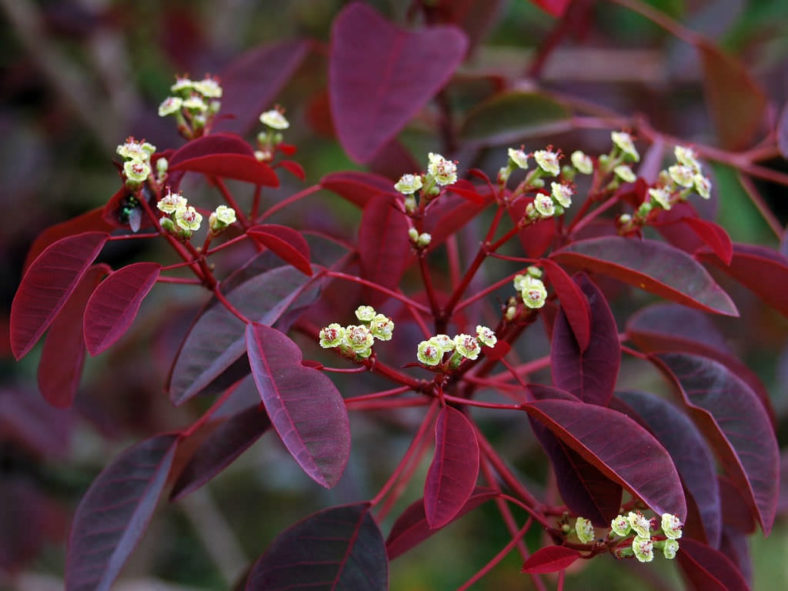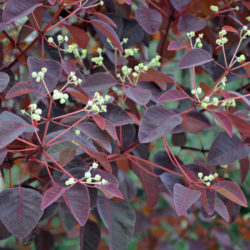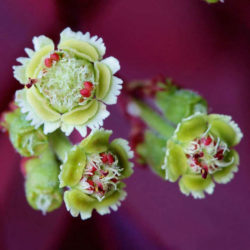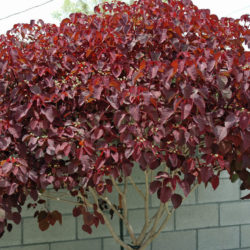Scientific Name
Euphorbia cotinifolia L.
Common Name(s)
Caribbean Copper Bush, Caribbean Copper Plant, Mexican Shrubby Spurge, Red Spurge, Smoketree Spurge, Tropical Smoke Bush
Synonym(s)
Aklema cotinifolia, Alectoroctonum cotinifolium, Euphorbia cotinifolia subsp. cotinifolia, Tithymalus cotinifolius
Scientific Classification
Family: Euphorbiaceae
Subfamily: Euphorbioideae
Tribe: Euphorbieae
Subtribe: Euphorbiinae
Genus: Euphorbia
Description
Euphorbia cotinifolia is an upright shrub or small tree prized for its ornamental foliage. It is strongly branched and can grow up to 10 feet (3 m) tall. The stems are purplish and bear broadly ovate, slightly fleshy leaves with a beautiful deep burgundy color and bright red venation. The leaves can reach up to 2.4 inches (6 cm) in length and up to 2 inches (5 cm) in width and are attached to the stem by slender, up to 2.4 inches (6 cm) long petioles.
Flowering occurs from late spring to mid-summer. The inflorescences are relatively inconspicuous, produced as small, few-branched terminal cymes consisting of tiny cyathia with purplish glands and creamy petal-like bracts that contrast attractively with the red foliage. The fruits are 3-locular capsules about 0.25 inches (0.6 cm) in diameter and contain brown seeds.
The species is often sold under the cultivar names Euphorbia cotinifolia 'Atropurpurea' or Euphorbia cotinifolia 'Burgundy Wine'.
Origin
Euphorbia cotinifolia is native to Mexico through Central America to northern South America.

Hardiness
USDA hardiness zone 9a to 11b: from 20 °F (−6.7 °C) to 50 °F (+10 °C).
How to Grow and Care
Euphorbias are very easy to care for. They require a little pampering to become established, but once they are, they are self-sufficient. More die from too much care and watering than from neglect. Euphorbias need well-draining soil and lots of sunlight. They are not particular about soil pH but cannot tolerate wet soil. Unlike most succulents, Euphorbia does not handle long periods of drought well. It may need weekly watering during the summer. Water whenever the soil is dry several inches below the surface. Water deeply, but don't let them sit in wet soil, which can cause root rot. Add some organic matter or fertilizer to the planting hole. Feed with a half-strength fertilizer monthly if you are growing them in containers or your soil is poor.
Euphorbia can be grown from seed, but they can be difficult to germinate (or even find). It is usually propagated by cuttings. This can be tricky because of the exuding sap. Rooting hormone is recommended with Euphorbias. They tend to grow problem-free, but there are a few pests and diseases to be alert for.
See more at How to Grow and Care for Euphorbia.
Links
- Back to genus Euphorbia
- Succupedia: Browse succulents by Scientific Name, Common Name, Genus, Family, USDA Hardiness Zone, Origin, or cacti by Genus
Photo Gallery
Click on a photo to see a larger version.


